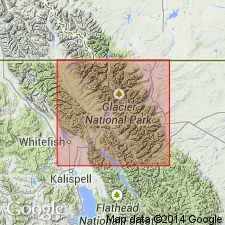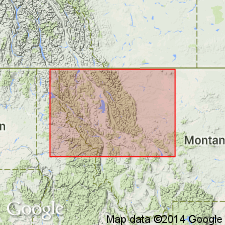
- Usage in publication:
-
- Rising Wolf member
- Modifications:
-
- First used
- Dominant lithology:
-
- Quartzite
- Argillite
- AAPG geologic province:
-
- Northern Rocky Mountain region
Summary:
First published use as upper member of three members of Appekunny formation of Belt series. Intent to name not stated. No type locality designated. Source of geographic name is probably Rising Wolf Mountain, Glacier National Park, MT in the Northern Rocky Mountain region. Is 200-500 ft thick in generalized section compiled from information on rocks south of Ahern Pass in Lewis Range and in Boulder Pass, Clark Range, and Waterton Lakes National Park, MT and CN, but areal extent not clearly stated. Composed of thick-bedded, green to red quartzite with subordinate gray and red meta-argillite. Mud cracks and ripple marks common. "Sand" distributed in argillite as thin sheets and lenses. Exposed on many peaks. Overlies Appistoki member (first published use) of Appekunny. Underlies Red Gap member (first published use) of Grinnell formation. Of Algonkian, Proterozoic age.
Source: GNU records (USGS DDS-6; Denver GNULEX).

- Usage in publication:
-
- Rising Wolf member
- Modifications:
-
- Revised
- AAPG geologic province:
-
- Northern Rocky Mountain region
Summary:
Removed from Appekunny formation as its upper member and reassigned to Grinnell formation as its basal member. Grinnell is the upper formation of the Ravalli group of the Belt series. Type locality [none designated in first published report] stated to be on southern slopes of Rising Wolf Mountain, Glacier National Park, MT in the Northern Rocky Mountain region. Occurs in Two Medicine and Dry Fork valleys, Ptarmigan Lake, but regional aspect of areal extent not clearly stated. Distinguished only in the eastern, dominantly argillaceous Grinnell. Composed of alternating quartzite and argillite, both of which have mud breccias, in Two Medicine and Dry Fork valley. Has both symmetrical and asymmetrical ripple marks, mud cracks, cross-bedding, mud breccias, and mud balls prevalent. Has white and pink to gray and green quartzite. Argillite may be red to brick red. Thickness ranges from 200-700 ft. Overlies Scenic Point member (new) of Appekunny. Underlies Red Gap member of Grinnell. Of pre-Cambrian age. Correlation chart.
Source: GNU records (USGS DDS-6; Denver GNULEX).
For more information, please contact Nancy Stamm, Geologic Names Committee Secretary.
Asterisk (*) indicates published by U.S. Geological Survey authors.
"No current usage" (†) implies that a name has been abandoned or has fallen into disuse. Former usage and, if known, replacement name given in parentheses ( ).
Slash (/) indicates name conflicts with nomenclatural guidelines (CSN, 1933; ACSN, 1961, 1970; NACSN, 1983, 2005, 2021). May be explained within brackets ([ ]).

